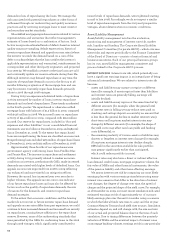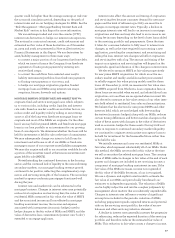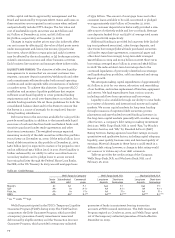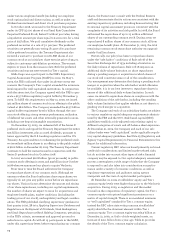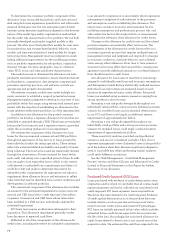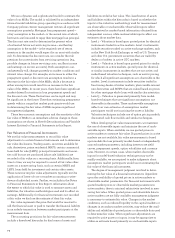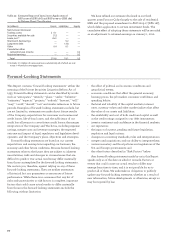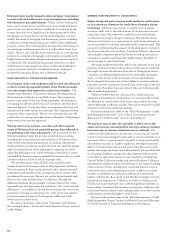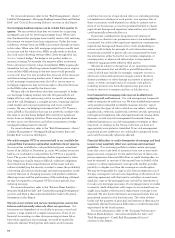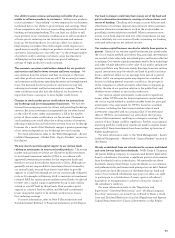Wells Fargo 2009 Annual Report Download - page 78
Download and view the complete annual report
Please find page 78 of the 2009 Wells Fargo annual report below. You can navigate through the pages in the report by either clicking on the pages listed below, or by using the keyword search tool below to find specific information within the annual report.
We use a dynamic and sophisticated model to estimate the
value of our MSRs. The model is validated by an independent
internal model validation group operating in accordance with
Company policies. Senior management reviews all significant
assumptions quarterly. Mortgage loan prepayment speed—
a key assumption in the model—is the annual rate at which
borrowers are forecasted to repay their mortgage loan principal.
The discount rate used to determine the present value
of estimated future net servicing income—another key
assumption in the model—is the required rate of return
investors in the market would expect for an asset with similar
risk. To determine the discount rate, we consider the risk
premium for uncertainties from servicing operations (e.g.,
possible changes in future servicing costs, ancillary income
and earnings on escrow accounts). Both assumptions can,
and generally will, change quarterly as market conditions and
interest rates change. For example, an increase in either the
prepayment speed or discount rate assumption results in a
decrease in the fair value of the MSRs, while a decrease in
either assumption would result in an increase in the fair
value of the MSRs. In recent years, there have been significant
market-driven fluctuations in loan prepayment speeds and
the discount rate. These fluctuations can be rapid and may
be significant in the future. Therefore, estimating prepayment
speeds within a range that market participants would use
in determining the fair value of MSRs requires significant
management judgment.
These key economic assumptions and the sensitivity of the
fair value of MSRs to an immediate adverse change in those
assumptions are shown in Note 8 (Securitizations and Variable
Interest Entities) to Financial Statements in this Report.
Fair Valuation of Financial Instruments
We use fair value measurements to record fair value
adjustments to certain financial instruments and to determine
fair value disclosures. Trading assets, securities available for
sale, derivatives, prime residential MHFS, certain commercial
loans held for sale (LHFS), principal investments and securi-
ties sold but not yet purchased (short sale liabilities) are
recorded at fair value on a recurring basis. Additionally, from
time to time, we may be required to record at fair value other
assets on a nonrecurring basis, such as certain MHFS and
LHFS, loans held for investment and certain other assets.
These nonrecurring fair value adjustments typically involve
application of lower-of-cost-or-market accounting or write-
downs of individual assets. Further, we include in the Notes
to Financial Statements in this Report, information about
the extent to which fair value is used to measure assets and
liabilities, the valuation methodologies used and its effect on
earnings. Additionally, for financial instruments not recorded
at fair value we disclose the estimate of their fair value.
Fair value represents the price that would be received to
sell the financial asset or paid to transfer the financial liability
in an orderly transaction between market participants at the
measurement date.
The accounting provisions for fair value measurements
include a three-level hierarchy for disclosure of assets and
liabilities recorded at fair value. The classification of assets
and liabilities within the hierarchy is based on whether the
inputs to the valuation methodology used for measurement
are observable or unobservable. Observable inputs reflect
market-derived or market-based information obtained from
independent sources, while unobservable inputs reflect our
estimates about market data.
• Level 1 – Valuation is based upon quoted prices for identical
instruments traded in active markets. Level 1 instruments
include securities traded on active exchange markets, such
as the New York Stock Exchange, as well as U.S. Treasury
and other U.S. government securities that are traded by
dealers or brokers in active OTC markets.
• Level 2 – Valuation is based upon quoted prices for similar
instruments in active markets, quoted prices for identical
or similar instruments in markets that are not active, and
model-based valuation techniques, such as matrix pricing,
for which all significant assumptions are observable in the
market. Level 2 instruments include securities traded in
functioning dealer or broker markets, plain-vanilla interest
rate derivatives and MHFS that are valued based on prices
for other mortgage whole loans with similar characteristics.
• Level 3 – Valuation is generated primarily from model-
based techniques that use significant assumptions not
observable in the market. These unobservable assumptions
reflect our own estimates of assumptions market
participants would use in pricing the asset or liability.
Valuation techniques include use of option pricing models,
discounted cash flow models and similar techniques.
When developing fair value measurements, we maximize
the use of observable inputs and minimize the use of unob-
servable inputs. When available, we use quoted prices in
active markets to measure fair value. If quoted prices in active
markets are not available, fair value measurement is based
upon models that use primarily market-based or independently
sourced market parameters, including interest rate yield
curves, prepayment speeds, option volatilities and currency
rates. However, in certain cases, when market observable
inputs for model-based valuation techniques may not be
readily available, we are required to make judgments about
assumptions market participants would use in estimating the
fair value of the financial instrument.
The degree of management judgment involved in deter-
mining the fair value of a financial instrument is dependent
upon the availability of quoted prices in active markets or
observable market parameters. For financial instruments with
quoted market prices or observable market parameters in
active markets, there is minimal subjectivity involved in mea-
suring fair value. When quoted prices and observable data in
active markets are not fully available, management judgment
is necessary to estimate fair value. Changes in the market
conditions, such as reduced liquidity in the capital markets or
changes in secondary market activities, may reduce the avail-
ability and reliability of quoted prices or observable data used
to determine fair value. When significant adjustments are
required to price quotes or inputs, it may be appropriate to
utilize an estimate based primarily on unobservable inputs.


